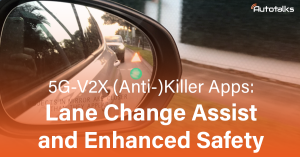By Sagit Adler
In the US alone, one person dies every 39 minutes due to drunk-driving crashes. According to the National Highway Traffic Safety Administration (NHTSA), in 2022, 13,524 people died in alcohol-impaired driving traffic deaths.[1] That’s a 16% increase from the 2020 statistics which show that 11,654 people died in alcohol-impaired driving crashes. This accounts for over 30% of all traffic-related deaths in the United States. This staggering statistic highlights the urgent need for a solution. Vehicle-to-Everything (V2X) communication might very well be the answer. It can give drivers, sober or drunk, the much needed extra time to react to road dangers.
V2X can mitigate drunk driving accidents by helping detect drunk drivers and alerting the surrounding road users. Additionally, it can help give impaired drivers warnings of upcoming potential dangers, allowing them more time to reacts.
Drunk Driver detection
V2X technology has its ability to detect erratic driving behavior, which is often indicative of impaired driving. V2X-equipped vehicles can monitor speed, lane positioning, trajectory and other driving behavior in real time. If a vehicle exhibits signs of reckless driving, such as swerving between lanes, constant hard braking or speeding, the V2X system can alert nearby drivers. Giving surrounding drivers those extra few seconds to react to a drunk driver, can often be the differentiating factor between an accident or a smooth ride. The surrounding drivers can take the time to slow downand wait before entering an intersection in order to let the dangerous driver pass, or even avert the danger by simply changing lanes.
V2X can help the impaired driver
Unfortunately, V2X cannot prevent someone who has been drinking to get behind the wheel, but it might help reduce the risk of crashing. Drinking alcohol can severely impact driving abilities. It leads to slower reaction times, impaired coordination, and decreased concentration.
A slower reaction time is one of the most common early effects of drinking alcohol. Often, people who drink might not feel “drunk”, but they are slower to respond to everything around them. For instance, drivers with a Blood Alcohol Concentration (BAC) of 0.08%—the legal limit in the United States—experience an average decrease in reaction time of about 120 milliseconds. This delay translates to an additional 12 feet of travel at 70 mph before reacting to a hazard.[2]
A recent Virginia Tech study, funded by the USDOT, showed that on average, V2X detects road dangers 0.5 seconds before any line-of-sight sensor.[3] This means that an impaired driver using a V2X equipped car would receive warnings a half a second earlier than they would with even the most reliable sensor. This is a significant improvement, especially compared to drivers without any sensors, who might not perceive the danger until much later. Statistics show that even an additional 0.5 seconds to react can make a crucial difference in preventing accidents.
V2X is needed
Approximately 31% of all traffic fatalities in the United States involve drunk drivers with a BAC of 0.08 g/dL or higher.[4] The statistics underscore the urgent need for innovative solutions to combat the devastating impact of drunk driving. V2X technology offers a promising solution to mitigate accidents in general including drunk driving accidents. As V2X technology continues to evolve and become more widely adopted, it promises to create safer roads and save countless lives. Embracing this technology, alongside ongoing efforts to promote responsible driving behavior, is a critical step toward a future where drunk driving accidents become a rarity.
See also: V2X Firmware, V2X Hardware
[1] https://www.nhtsa.gov/risky-driving/drunk-driving
[2] https://www.michiganmedicine.org/health-lab/how-alcohol-impairs-your-ability-drive
[3] https://www.mdpi.com/1424-8220/24/2/484
[4] https://www.iii.org/fact-statistic/facts-statistics-alcohol-impaired-driving








